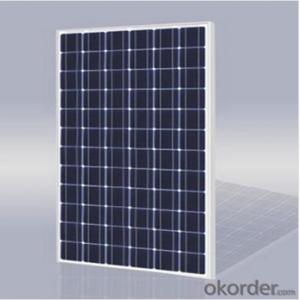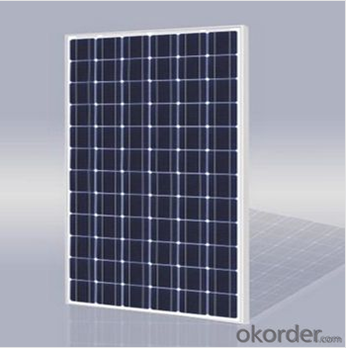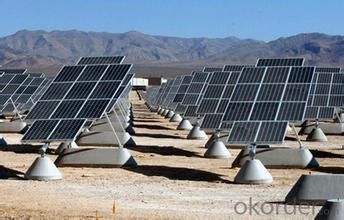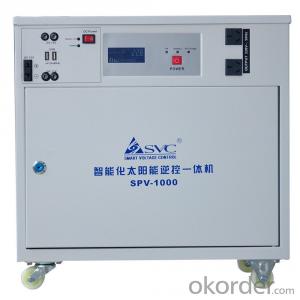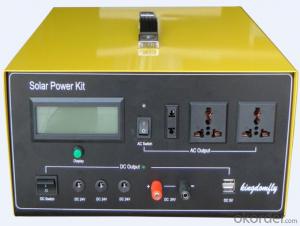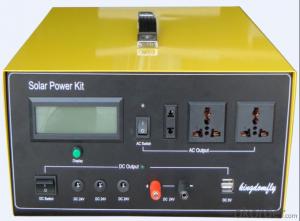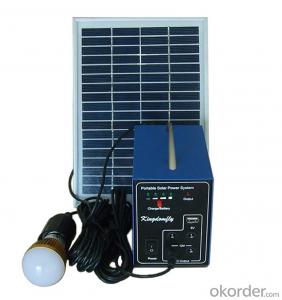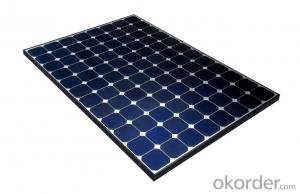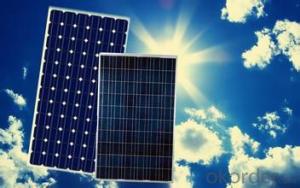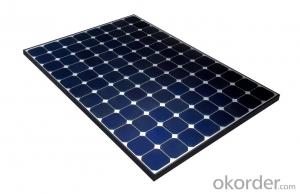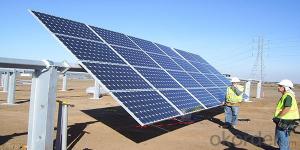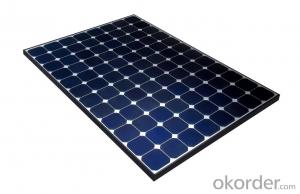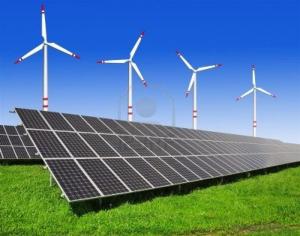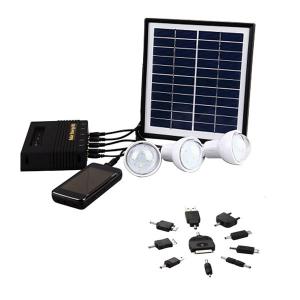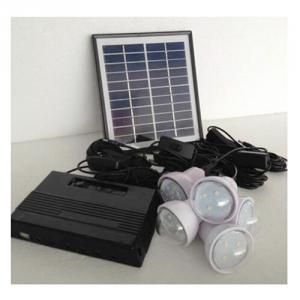Home Solar Energy Systems:130kw CNBM Monocrystalline Silicon Panel for Home Use
- Loading Port:
- Tianjin
- Payment Terms:
- TT OR LC
- Min Order Qty:
- 50 watt
- Supply Capability:
- 1000 watt/month
OKorder Service Pledge
OKorder Financial Service
You Might Also Like
Specification
130KW CNBM Monocrystalline Silicon Panel for Home Using
Production description
Off-the-grid homes are autonomous; they do not rely on municipal water supply, sewer, natural gas, electrical power grid, or similar utility house in the high-desert wilderness of Northern Arizona, collecting rainwater, composting waste, and paying nothing for utilities.[4][5]
The large magnitude of solar energy available makes it a highly appealing source of electricity. The United Nations Development Programme in its 2000 World Energy Assessment found that the annual potential of solar energy was 1,575–49,387 exajoules (EJ). This is several times larger than the total world energy consumption, which was 559.8 EJ in 2012.
Electrical power can be generated on-site with renewable energy sources such as solar (particularly with photovoltaics), wind, micro hydro, geothermal; with agenerator or Micro combined heat and power with adequate fuel reserves. Such a system is called a stand-alone power system. In addition, it is possible to simply eliminate electric power such as in Old Order Amish and Old Order Mennonite communities.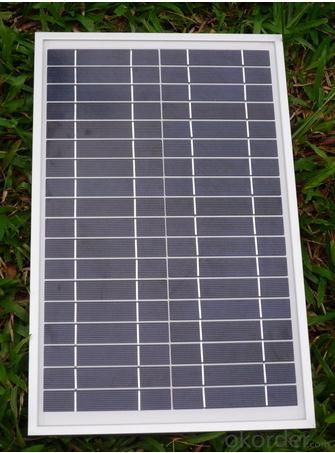
Feature
1.High conversion efficiencies resulting in superior power output performance.
2.Outstanding power output even in low light or high temperature conditions
3.Optimized design for ease of soldering and lamination
Physical characteristic
1. Rigorous quality control meets the highest international standards.
2. High-transmissivity low-iron tempered glass, strong aluminium frame.
3. Using UV-resistant silicon.
4. IS09001/14001/CE/TUV/UL
Packaging
26pcs in one carton 6pallets in 20foot container 14pallets in 40 foot container.
- Q: Can solar energy systems be used in disaster relief efforts?
- Indeed, solar energy systems have proven to be effective in disaster relief endeavors, gaining popularity and significance in such situations. When calamities strike, they frequently disrupt the electricity supply, leaving affected areas devoid of power for extended periods, ranging from days to even weeks. This absence of electricity hinders relief efforts, impeding the provision of basic necessities such as lighting, medical care, communication, and clean water. In contrast, solar energy systems offer a dependable and sustainable power source in these circumstances. Consisting of solar panels that convert sunlight into electricity, these systems can energize various devices and appliances. They can be rapidly deployed to disaster-stricken regions, providing immediate access to electricity without relying on conventional power grids. There are numerous advantages to employing solar energy systems in disaster relief operations. Firstly, solar power is renewable and abundant, ensuring a continuous electricity supply even during prolonged emergencies. Secondly, these systems typically require minimal maintenance, decreasing the need for constant fuel supply or repairs. Consequently, they are more cost-effective and reliable in disaster-prone areas. Solar energy systems can be utilized in various ways during disaster relief endeavors. For instance, they can power mobile charging stations, enabling individuals to charge their phones and stay connected with their loved ones. Solar-powered lighting can illuminate temporary shelters, hospitals, and walkways, enhancing safety and security for victims and aid workers alike. Additionally, solar energy can power water purification systems, guaranteeing access to clean drinking water in regions where water infrastructure has been damaged or contaminated. Moreover, solar energy systems can be seamlessly integrated into existing relief infrastructure. Hospitals, schools, and community centers can have solar panels installed on their roofs, ensuring a reliable electricity source for critical operations. This reduces reliance on diesel generators or other fossil fuel-powered alternatives, which tend to be costly, noisy, and emit harmful pollutants. In conclusion, solar energy systems are immensely advantageous in disaster relief efforts. They offer a sustainable and dependable power source, facilitating essential services and enhancing overall relief operations. As the world grapples with increasingly frequent and severe natural disasters, the utilization of solar energy systems in disaster relief will continue to gain significance.
- Q: How does the angle of solar panels affect their efficiency?
- The angle of solar panels significantly affects their efficiency. By adjusting the angle, panels can maximize their exposure to sunlight, ensuring optimal energy absorption. The ideal angle varies depending on the geographical location, time of year, and panel type. A properly adjusted angle can increase the efficiency of solar panels and ultimately enhance their electricity generation.
- Q: Can solar energy systems be used for powering off-grid space exploration missions?
- Yes, solar energy systems can be used for powering off-grid space exploration missions. Solar panels can capture sunlight and convert it into electricity, providing a reliable and sustainable source of power for various systems and equipment used in space missions. This reduces the need for traditional fuel-based generators and can significantly extend the mission duration and capabilities in remote and off-grid locations.
- Q: What is the ideal direction for solar panels to face?
- The ideal direction for solar panels to face is south (in the northern hemisphere) or north (in the southern hemisphere). This orientation allows the panels to capture maximum sunlight throughout the day, optimizing their energy generation.
- Q: What is the role of surge protectors in a solar energy system?
- Surge protectors play a crucial role in a solar energy system by safeguarding the system against power surges and voltage spikes. Solar energy systems generate electricity through photovoltaic panels, which convert sunlight into usable energy. However, electrical disturbances such as lightning strikes, grid fluctuations, or equipment malfunctions can cause sudden voltage surges that can potentially damage the solar panels, inverters, and other components of the system. A surge protector serves as a protective barrier by diverting excess voltage away from the system, preventing it from reaching and potentially damaging sensitive equipment. It works by monitoring the electrical current flowing through the system and automatically redirecting any excess voltage to a grounding wire or dissipating it safely. This helps to maintain a stable and consistent flow of electricity, ensuring the longevity and performance of the solar energy system. In addition to protecting against power surges, surge protectors also mitigate the risk of electrical fires that can occur due to overvoltage situations. By preventing excessive voltage from reaching critical components, surge protectors significantly reduce the chances of electrical failures and potential fire hazards. Furthermore, surge protectors enhance the overall safety of the solar energy system by providing a layer of protection for the homeowners and professionals working on the system. They create a reliable barrier that prevents electrical shocks by diverting high voltages away from the system and grounding them safely. Overall, surge protectors are an essential component in a solar energy system as they protect against power surges, voltage spikes, and potential electrical hazards. By ensuring the system's integrity and safety, surge protectors contribute to the optimal performance and longevity of the solar energy system.
- Q: Are there any limitations to using solar energy for powering vehicles?
- Yes, there are limitations to using solar energy for powering vehicles. One major limitation is the dependence on sunlight, which means solar-powered vehicles may not be suitable for regions with limited sunlight or during nighttime. Additionally, solar panels are bulky and require a large surface area to generate enough energy, making it challenging to fit them on small vehicles. The efficiency of solar panels is also affected by factors like dust, dirt, and shading, which can reduce their effectiveness. Furthermore, the cost of solar panels and their storage systems can be relatively high, making the initial investment expensive.
- Q: How do solar energy systems impact the demand for traditional energy sources?
- Traditional energy sources are significantly impacted by solar energy systems, as the installation and integration of solar panels into the power grid decrease reliance on fossil fuels. This occurs because solar energy systems directly generate electricity from sunlight, eliminating the necessity for coal, oil, and natural gas as traditional energy sources. Several factors contribute to the reduced demand for traditional energy sources with the increased adoption of solar energy systems. Firstly, solar power can be produced locally, reducing the need for long-distance electricity transmission from power plants. Consequently, transmission losses and associated costs decrease, rendering solar energy more economically viable. Secondly, solar energy systems generate electricity during daylight hours when demand is typically high, especially in residential and commercial settings. As a result, strain on traditional energy sources during peak demand periods is reduced, assisting in stabilizing the power grid and preventing blackouts or shortages. Additionally, integrating solar energy systems into the power grid allows for excess electricity to be fed back into the grid. This surplus energy can be utilized by other consumers, thereby lowering the overall demand for traditional energy sources. This concept, referred to as net metering, not only diminishes reliance on traditional energy sources but also encourages the adoption of solar energy systems. In conclusion, the widespread use of solar energy systems positively impacts the demand for traditional energy sources. It diminishes the requirement for fossil fuels, promotes energy independence, and contributes to the global transition toward clean and renewable energy sources. However, it is important to acknowledge that replacing traditional energy sources entirely with solar energy is not feasible in all circumstances, and a balanced energy mix remains necessary to meet the diverse energy demands of society.
- Q: Can solar energy systems be used for commercial or industrial purposes?
- Yes, solar energy systems can be used for commercial or industrial purposes. Many businesses and industries are adopting solar energy systems to meet their energy needs and reduce their reliance on traditional fossil fuel sources. Solar power is a cost-effective and sustainable option for powering commercial buildings, factories, warehouses, and other industrial facilities. It helps businesses save on energy costs, reduce carbon emissions, and demonstrate their commitment to environmental sustainability.
- Q: How do solar energy systems impact the reliability of electricity supply?
- The reliability of electricity supply is greatly improved by solar energy systems. These systems harness the energy of the sun to produce electricity that is clean, renewable, and plentiful. This reduces our dependence on traditional fossil fuel-based power generation, which is vulnerable to price fluctuations and supply disruptions. One of the main benefits of solar energy is its distributed nature. Solar panels can be installed on rooftops or in small-scale setups throughout a community, creating a decentralized model of electricity generation. This approach helps mitigate the risks of large-scale power outages caused by natural disasters, equipment failures, or grid disturbances. In the event of a local blackout or grid failure, solar energy systems can continue to provide electricity to homes, businesses, and critical infrastructure, ensuring a more dependable power supply. Moreover, solar power systems can enhance grid stability and reliability by reducing peak demand on the electricity grid. Solar energy production typically aligns with peak demand periods, such as hot summer afternoons when air conditioning usage is high. By generating electricity during these peak periods, solar systems alleviate strain on the grid, decreasing the likelihood of blackouts or voltage fluctuations. Additionally, solar energy systems can be combined with energy storage technologies, like batteries, to offer backup power during periods of low sunlight or grid outages. These energy storage solutions enable surplus solar energy to be stored and utilized when necessary, further bolstering the reliability and resilience of electricity supply. In conclusion, solar energy systems have a positive impact on the reliability of electricity supply by providing a decentralized and distributed generation model, reducing strain on the grid during peak demand periods, and offering backup power through energy storage solutions. By diversifying our energy sources and embracing solar power, we can create a more resilient and dependable electricity supply system.
- Q: Can solar energy systems be integrated with other energy sources?
- Yes, solar energy systems can be integrated with other energy sources. In fact, this is a common approach in many applications to ensure a reliable and consistent supply of electricity. Solar energy is intermittent, as it depends on the availability of sunlight. Therefore, integrating solar energy systems with other energy sources, such as batteries or a power grid, can help to store excess energy generated during sunny periods and provide electricity when there is no sunlight. One popular method of integration is through the use of hybrid systems, where solar panels are combined with other renewable energy sources like wind or hydroelectric power. This allows for a more consistent and reliable energy supply, as different sources can compensate for each other's fluctuations. Additionally, solar energy systems can also be integrated with traditional energy sources like natural gas or coal-based power plants. This allows for the reduction of carbon emissions and the transition towards a cleaner and more sustainable energy mix. By combining solar energy with other sources, the overall energy generation capacity is increased, providing a more stable and secure energy supply. Overall, integrating solar energy systems with other energy sources is a practical and effective way to maximize the benefits of renewable energy while ensuring a continuous and reliable electricity supply.
Send your message to us
Home Solar Energy Systems:130kw CNBM Monocrystalline Silicon Panel for Home Use
- Loading Port:
- Tianjin
- Payment Terms:
- TT OR LC
- Min Order Qty:
- 50 watt
- Supply Capability:
- 1000 watt/month
OKorder Service Pledge
OKorder Financial Service
Similar products
Hot products
Hot Searches
Related keywords
